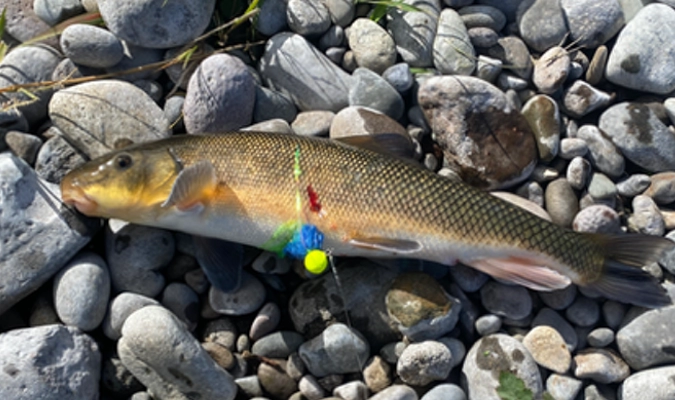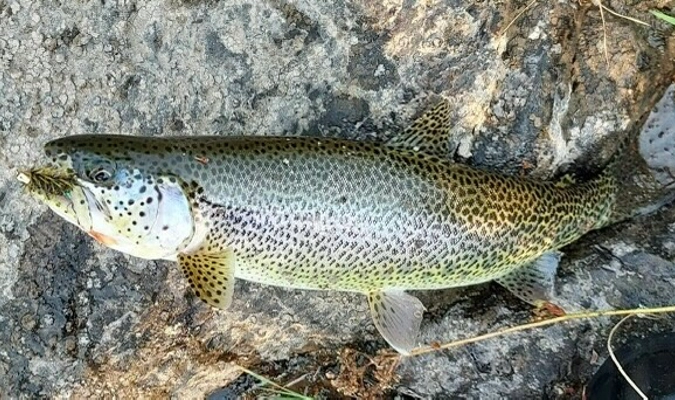Fall is an excellent time to experience the magic of fly fishing on the North Santiam River in Oregon. As the crisp autumn air rolls in and the leaves paint the landscape with vibrant reds and golds, the river becomes a stage for one of the season’s most compelling angling experiences. For fly fishers, the fall is about the afternoon hatches of Pale Morning Duns (PMDs), October Caddis, and Blue-Winged Olives (commonly called Blue Morning Duns). These hatches create a unique window of opportunity to target the river’s eager trout. Read more of our North Santiam River Fishing Report: October 2024.
Fall PMD Hatch
The Pale Morning Dun hatch is a late-season delight. While PMDs are more commonly associated with summer, their fall appearance is a treat for fly fishers. These smaller mayflies, usually in the size 16-18 range, begin to emerge in the early afternoon as the day warms. The trout rise eagerly to intercept the duns as they struggle on the surface. A parachute PMD or a Comparadun pattern, carefully presented, often does the trick. Look for slower runs and back eddies where the bugs accumulate, and don’t forget to carry a selection of PMD nymphs for subsurface presentations if the fish are feeding below.
October Caddis
The October Caddis is arguably the headliner of the month. These large, orange-bodied caddisflies are unmistakable and impossible for trout to ignore. They typically emerge later in the afternoon and into the evening, making them an ideal target as the day winds down. A size 8-10 Elk Hair Caddis or Stimulator pattern with a hint of orange is perfect for mimicking these robust insects. Dead-drifting your fly along seams or adding an occasional twitch to simulate a struggling adult can be highly effective. The trout’s takes on October Caddis patterns are often aggressive, so be prepared for an exciting fight.
Blue Morning Dun Hatch
The Blue Morning Dun, or Blue-Winged Olive (BWO), hatch is a fall staple, especially during overcast afternoons. These tiny mayflies, usually in sizes 18-22, emerge in prolific numbers, creating feeding frenzies among the trout. A well-presented BWO emerger or dry fly is often met with enthusiastic rises. Focus on riffles and faster-moving water where these bugs tend to congregate. When the surface action slows, switching to nymphs or soft hackles can keep you in the game.
Trout Spey Tactics-North Santiam River Fishing Report: October 2024
While traditional dry fly fishing shines during the hatches, incorporating trout spey tactics can elevate your experience on the North Santiam. In the early part of the day, before the hatches intensify, using a trout spey rod with sink tips and streamers can be incredibly productive. Patterns like sculpins, leeches, or smaller baitfish imitations swung through deeper pools and runs often entice the river’s larger trout. The rhythmic casting and swinging of a trout spey rod also allow you to cover more water efficiently.
When the hatches begin, switching to soft hackles can be a game-changer. A two-fly rig with a larger soft hackle, such as an orange and partridge for October Caddis, trailed by a smaller PMD or BWO soft hackle, can effectively mimic emerging insects. Swinging these patterns through riffles and seams during the peak of the hatch can produce memorable strikes.
Planning Your Trip
October days on the North Santiam are marked by cool mornings and pleasant afternoons. Dress in layers to stay comfortable, and bring your waders to access prime water. The river’s flows are generally stable this time of year, but always check conditions before heading out. A good selection of flies, from PMDs and BWOs to October Caddis and streamers, is essential. Polarized sunglasses will help you spot fish and read the water effectively.
Whether you’re a seasoned angler or new to the sport, the North Santiam River offers an unforgettable fly fishing experience in October. Combining vibrant scenery, abundant hatches, and diverse tactics ensures something for everyone. Don’t miss the chance to chase wild trout amidst the splendor of autumn’s embrace. We can help with our river shuttle service.

Not everyone is a fly angler, so here is the gear report for October 2024. October 2024 is an excellent time to experience the magic of gear fishing on the North Santiam River in Oregon. As the crisp autumn air rolls in and the leaves paint the landscape with vibrant reds and golds, the river becomes a hotspot for coho salmon, steelhead, and more. Anglers employing twitch jigs, balsa wood bobbers with hair jigs, and swinging spinners or spoons will find ample opportunities for success.
Twitch Jigs for Coho Salmon
One of the most effective methods for targeting coho salmon in October is using twitch jigs. These lures, often in bright colors like pink, purple, or chartreuse, are designed to mimic a distressed baitfish. Twitching involves casting the jig into deep pools or along current seams and retrieving it with sharp upward jerks of the rod, allowing the jig to flutter enticingly back down. Coho salmon are aggressive in the fall, and the erratic movement of a twitch jig often triggers hard strikes. Focus on areas with slower-moving water adjacent to riffles or runs, as coho tend to hold in these spots.
Balsa Wood Bobbers and Hair Jigs
For a more subtle approach, consider fishing with balsa wood bobbers and hair jigs. This method is particularly effective in deeper holes and slower currents. The balsa wood bobber provides excellent sensitivity, allowing you to detect even the slightest takes. Hair jigs, often tipped with a small piece of cured roe or shrimp, can be fished beneath the bobber at a controlled depth. This setup is especially productive for steelhead, which are known to take these presentations readily during their upstream migration. Adjust your depth as needed to keep the jig just off the bottom, and keep an eye on your bobber for any unusual movement.
Swinging Spinners and Spoons for Steelhead and Salmon
Another tried-and-true tactic for October on the North Santiam is swinging spinners and spoons. These lures excel at covering water and enticing fish in a wide range of conditions. Popular choices include Blue Fox spinners and Little Cleo spoons in silver, gold, or copper finishes. The flashing and wobbling action of these lures mimics baitfish, drawing aggressive strikes from both steelhead and salmon. Cast across the current and retrieve at a steady pace, allowing the lure to swing naturally through the water column. Varying your retrieve speed and adding occasional pauses can enhance the action and trigger more strikes.
Planning Your Gear Fishing Trip
October days on the North Santiam are marked by cool mornings and mild afternoons. Dressing in layers is essential to stay comfortable, and waterproof gear like waders and rain jackets will keep you prepared for changing weather conditions. A medium to medium-heavy spinning rod paired with a quality reel and braided line in the 20-30 lb range is ideal for handling the powerful salmon and steelhead found in the river.
When selecting lures, carry a variety of twitch jigs, hair jigs, spinners, and spoons to adapt to the conditions and fish behavior. A sturdy landing net is also essential, as is a pair of polarized sunglasses to help spot holding fish and read the water effectively. Always check local regulations and ensure you have the appropriate fishing license and tags for the species you’re targeting.
Why October?
The North Santiam River in October offers a unique blend of scenic beauty and angling opportunities. The coho salmon are at their peak, and steelhead are moving through the system in good numbers. Whether you’re twitching jigs, drifting hair jigs under a bobber, or swinging spinners and spoons, the river provides a rewarding challenge for anglers of all skill levels.
Don’t miss the chance to gear fish one of Oregon’s premier rivers this fall. With the right tactics and a bit of patience, you’re sure to create lasting memories and, hopefully, land some impressive fish along the way. Thanks for reading the North Santiam River Fishing Report: October 2024. If we can help you with a shuttle ride, book now.


